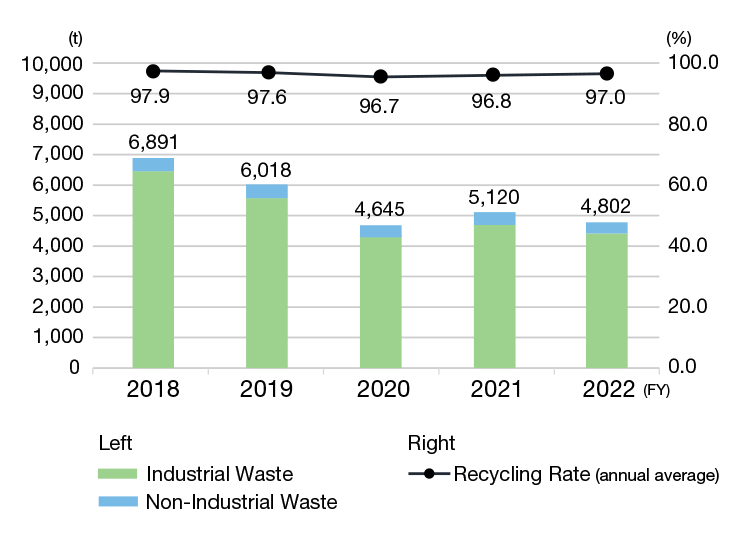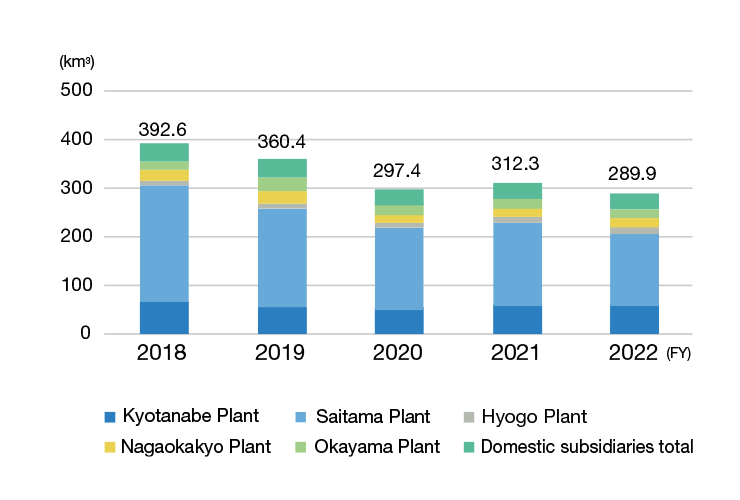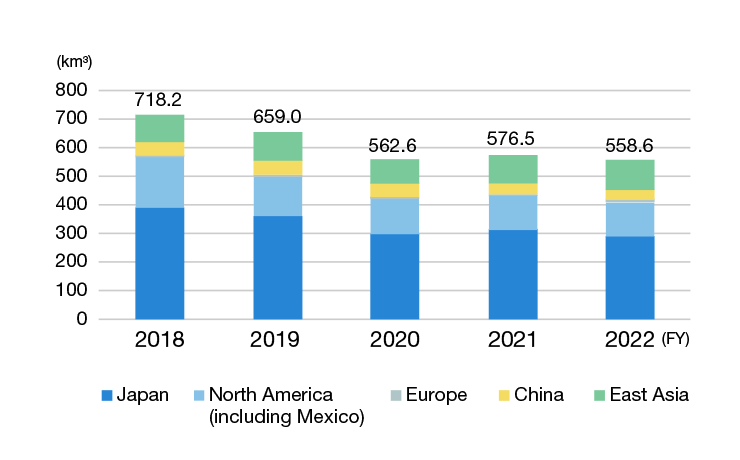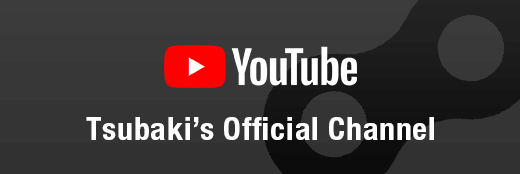Initiatives for a Recycling-oriented Society and Pollution Prevention
The Tsubaki Group is advancing initiatives designed to realize a circular economy with a low environmental impact by creating higher economic value through the reduced use of resources while promoting the reduce, reuse, recycle (“3R”) approach.
* Three R’s: An abbreviation of Reduce, Reuse, Recycle.
Reducing Total Weight of Waste Discharged
The Group has established key performance indicators aligned with the Four Principles and Eight Items of Sustainability, focusing on the reduction of waste (including both industrial and general waste), an enhancement in recycling rates, and the total weight of waste discharged, encompassing Sale of Valuable Resouces. (Set as one of the management indicators of the Tsubaki Group’s original EcoFactory Certification System)
We are actively executing reduction initiatives to significantly decrease our consumption of materials sourced from the Earth's natural resources.
List of Total Weights of Waste Discharged, Broken Down by Facility
Unit: t/year
| FY 2021 | FY 2022 | ||||||
|---|---|---|---|---|---|---|---|
| All Waste | Sale of Valuable Resources | Total Waste Discharged | All Waste | Sale of Valuable Resources | Total Waste Discharged | ||
| Tsubakimoto Chain |
Kyotanabe Plant | 511 | 8,583 | 9,095 | 519 | 8,665 | 9,184 |
| Saitama Plant | 1,533 | 7,787 | 9,320 | 1,434 | 7,831 | 9,266 | |
| Hyogo Plant | 129 | 13 | 142 | 131 | 9 | 140 | |
| Nagaokakyo Plant | 335 | 915 | 1,250 | 306 | 794 | 1,101 | |
| Okayama Plant | 353 | 360 | 713 | 269 | 370 | 638 | |
| Affiliated Companies |
Tsubakimoto Custom Chain Co. | 174 | 806 | 980 | 171 | 715 | 810 |
| Tsubakimoto Sprocket Co. | 113 | 357 | 470 | 104 | 378 | 481 | |
| Tsubakimoto Bulk Systems Corp. | 31 | 204 | 234 | 29 | 168 | 197 | |
| Tsubakimoto Mayfran Inc. | 52 | 604 | 657 | 68 | 649 | 717 | |
| Tsubakimoto Iron Casting Co. | 1,849 | 34 | 1,883 | 1,730 | 39 | 1,768 | |
| Tsubaki Yamakyu Chain Co. | 39 | 52 | 91 | 42 | 53 | 95 | |
| Domestic total | 5,120 | 19,716 | 24,836 | 4,802 | 19,671 | 24,398 | |
Note: All waste = Industrial waste + General waste
List of Figures
| Total waste discharged/Unit | |||
|---|---|---|---|
| FY 2021 | FY 2022 | ||
| Tsubakimoto Chain |
Kyotanabe Plant | 0.464 | 0.430 |
| Saitama Plant | 0.307 | 0.304 | |
| Hyogo Plant | 0.176 | 0.132 | |
| Nagaokakyo Plant | 0.122 | 0.097 | |
| Okayama Plant | 0.104 | 0.103 | |
| Affiliated Companies |
Tsubakimoto Custom Chain Co. | 0.193 | 0.155 |
| Tsubakimoto Sprocket Co. | 0.161 | 0.151 | |
| Tsubakimoto Bulk Systems Corp. | 0.056 | 0.052 | |
| Tsubakimoto Mayfran Inc. | 0.248 | 0.197 | |
| Tsubakimoto Iron Casting Co. | 1.402 | 1.310 | |
| Tsubaki Yamakyu Chain Co. | 0.030 | 0.030 | |
| Domestic total | 0.285 | 0.269 | |
Note: Total waste ÷ Production
Improvement of Recycling Rate
The Group takes a proactive approach to reducing and recycling waste. In FY 2022, the combined total amount of industrial and general waste emissions was 4,802 tons, representing a decrease of 6.2% year-on-year. The recycling rate remained high at an annual average of 97.0% for the fiscal year.
-
Waste Emission and Recycling Rate (Fiscal Year Average)
Unit: t, %
2018 2019 2020 2021 2022 Industrial waste 6,452 5,573 4,300 4,708 4,419 General waste 440 445 345 412 383 Total 6,891 6,018 4,645 5,120 4,802 Recycling rate
(annual average)97.9 97.6 96.7 96.8 97.0 -

The scope of the report is 11 major manufacturing sites in Japan; overseas data is not included, as the definitions of disposal operations differ from country to country.
Initiatives to Reduce the Use of Hazardous Chemical Substances
In response to Japanese and international legislation concerning hazardous chemical substances, the Tsubaki Group identifies substances contained in the raw materials, parts, and other materials used. By also working with our customers to gain a detailed understanding of the usage of hazardous chemical substances and establish permissible levels, we continue to focus on reducing the use of such substances.
In our Green Procurement Guidelines, we require our suppliers to reduce the use of hazardous chemical substances by specifying the applicable laws and regulations, identifying the substances, listing standard values, and other measures.
| Laws and Regulations | Compliant Products |
|---|---|
| RoHS Directive (2011/65/EU) |
|
| RoHS Directive (2002/95/EC) |
Mechanical protectors |
| ELV directive | All components for automotive engine timing chain systems |
* RoHS directive: An EU directive regulating the use of certain hazardous substances in electrical and electronic equipment.
2002/95/EC (RoHS 1) was promulgated in February 2003 and 2011/65/EU (RoHS 2) was promulgated in July 2011.
* ELV directive: An EU directive restricting the use of lead, mercury, cadmium, and hexavalent chromium as a general rule to reduce waste from end-of-life vehicles (ELVs) and encourage appropriate disposal.
Reducing the Use of Chemical Substances Subject to the PRTR Law
The Tsubaki Group surveys emissions of chemical substances specified by the Chemical Substance Removal Management Promotion Law (PRTR Law) and continuously works to reduce such substances and switch to less hazardous substances. In FY 2022, the Group’s annual PRTR report discovered the presence of such substances in seven plants at four companies. The Tsubaki Group has adopted PRTR control as a management indicator under the EcoFactory Certification System, and is reducing the use of strictly controlled substances also at plants that are not required to report under this system.
FY 2022 data on chemical substances subject to the PRTR Law
Unit: kg/year
| Business Site | Substance No. | Substance Name | Amount Released | Amount Transferred | Total | |||||
|---|---|---|---|---|---|---|---|---|---|---|
| Atmosphere | Public Water Supply | Soil | On-site Landfill | Sewer | Transferred to Off-site Business | |||||
| Tsubakimoto Chain Co. | Kyotanabe Plant | 348 | 1-bromopropane | 12,900.0 | 0 | 0 | 0 | 0 | 0 | 12,900 |
| Saitama Plant | 80 | Xylene | 1,500.0 | 0 | 0 | 0 | 0 | 0 | 1,500 | |
| 87 | Chromium and chromium (III) compounds | 30.0 | 0 | 0 | 0 | 0 | 15,000.0 | 15,030 | ||
| 300 | Toluene | 35,000.0 | 0 | 0 | 0 | 0 | 6,900.0 | 41,900 | ||
| Hyogo Plant | 438 | Methylnaphthalene | 3.2 | 0 | 0 | 0 | 0 | 0 | 3 | |
| Nagaokakyo Plant | 53 | Ethylbenzene | 1,105.3 | 0 | 0 | 0 | 0 | 35.7 | 1,141 | |
| 80 | Xylene | 1,616.7 | 0 | 0 | 0 | 0 | 52.3 | 1,669 | ||
| 300 | Toluene | 10,345.4 | 0 | 0 | 0 | 0 | 334.6 | 10,680 | ||
| Tsubakimoto Bulk Systems Corp. | 53 | Ethylbenzene | 3,357.4 | 0 | 0 | 0 | 0 | 443.6 | 3,801 | |
| 80 | Xylene | 5,240.5 | 0 | 0 | 0 | 0 | 692.5 | 5,933 | ||
| 300 | Toluene | 1,808.1 | 0 | 0 | 0 | 0 | 238.9 | 2,047 | ||
| 438 | Methylnaphthalene | 0 | 0 | 0 | 0 | 0 | 0.3 | 0 | ||
| Tsubakimoto Mayfran Inc. | 53 | Ethylbenzene | 2,500.0 | 0 | 0 | 0 | 0 | 640.0 | 3,140 | |
| 80 | Xylene | 3,700.0 | 0 | 0 | 0 | 0 | 1,000.0 | 4,700 | ||
| 300 | Toluene | 15,900.0 | 0 | 0 | 0 | 0 | 4,200.0 | 20,100 | ||
| Tsubakimoto Iron Casting Co. | 412 | Manganese and its compounds | 2,634.0 | 0 | 0 | 0 | 0 | 541.7 | 3,176 | |
| Magnesium and its compounds | 2,132.0 | 0 | 0 | 0 | 0 | 85.3 | 2,217 | |||
| Total | 99,773 | 0 | 0 | 0 | 0 | 30,165 | 129,937 | |||
* Tsubakimoto Custom Chain, Tsubakimoto Sprocket, and Tsubaki Yamakyu Chain are outside the scope of PRTR filings.
Note 1: The values shown in the table above are compliant with laws and regulations.
Conservation of Water Resources
To protect our water resources, the Tsubaki Group is engaged in a global effort to reduce our total water use and water use intensity. At our locations in Japan, we have adopted voluntary management values for each business location according to the management indicators identified in the EcoFactory Certification System and are taking steps to reduce our water use. In FY 2017, we began measuring water use at our business locations outside Japan and have adopted measures to reduce it.
-
Water consumption (domestic)

-
Water consumption (global)




